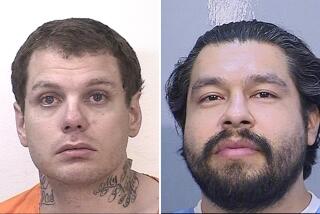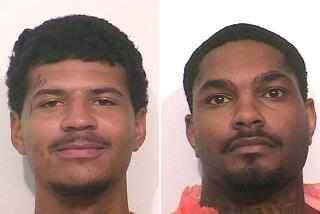Gang Member Gets Death
No city in Orange County has suffered more at the hands of gangs than Santa Ana, which recorded more than 200 gang-related murders in the past decade. But until Thursday, no Santa Ana gang member had been sentenced to death for his crimes.
It was a solemn milestone marked in the courtroom of Judge John J. Ryan, who handed down the sentence to a gang member convicted of killing a youth across the street from the Santa Ana Zoo.
Unlike many gang killings, this one involved someone authorities called an innocent victim, a recent high school graduate who stumbled upon a group of gang members while walking to a friend’s house in April 1999. Eduardo David Vargas forced his victim to lie on the ground before shooting him twice in the back of the head.
Prosecutors said several factors set the murder of Jesse Muro Jr. apart from other gang killings, including the grisly nature of the crime and unusually strong evidence that included testimony from two accomplices. Often, authorities have trouble persuading gang members to testify against their own.
“In a lot of these cases, it’s gang members killing other gang members, and society seems to put a lesser value in those cases. The difference in this case is the victim was a completely innocent bystander,” said Tustin Police Sgt. Tom Tarpley, who investigated the case.
In court Thursday, Muro’s older sister sobbed and his father held up pictures of his son, one taken when Muro was a child holding a Winnie the Pooh doll, another from his high school graduation.
They said the sentence was less about vindication than about hoping something positive comes out of the 17-year-old’s death.
“Maybe we can get the message out to gang members [that] if they’re going to do the ultimate crime, they’re going to pay the ultimate price,” Jesse Muro Sr. said. “We can’t tolerate this. . . . My son didn’t have a chance.”
Shortly before receiving the death sentence, Vargas apologized to Muro’s relatives, blaming his actions on drug abuse. As he spoke, relatives of Vargas and his victim cried softly.
“I know I can never bring back your loved one, Jesse. . . . [But] I honestly didn’t mean to shoot him. All I wanted to do was rob him, take his money,” Vargas said, his hands shackled to his chair. “I am not proud for what I did. Now I have to live with being a murderer for the rest of my life. I actually killed two people that day: one was Jesse, one was me.”
Defense lawyer Rob Harley argued that Vargas, 23, deserved leniency because he had no prior record of violence and was raised in an impoverished neighborhood that left him susceptible to the gang lifestyle.
But Ryan rejected those pleas. The judge said he was swayed by the second gunshot, which he said proved the killing was intentional.
“Vargas apparently wanted Mr. Muro to never be able to identify him,” the judge said. “One shot could have accomplished Mr. Vargas’ goal, but he had to be sure and fire the second shot.”
Authorities have long struggled in prosecuting gang crimes, in part because witnesses are afraid to implicate gang members and because gang members, both victim and accomplices, often refuse to testify against each other.
“These are very difficult cases to investigate,” said Santa Ana Police Chief Paul Walters. “Most of the time [when] our investigators get there, no one will cooperate. It takes the longest time to even find out what happened.”
In the Vargas case, Assistant Dist. Atty. Marc Rozenberg granted immunity to two gang associates whose testimony helped make the case.
Until recently, most gang killers were not eligible for the death penalty. Vargas was eligible because he robbed his victim, creating a “special circumstance.”
Rozenberg said a new law, approved after Muro’s death, makes all gang killers eligible for death sentences.
More to Read
Sign up for Essential California
The most important California stories and recommendations in your inbox every morning.
You may occasionally receive promotional content from the Los Angeles Times.










